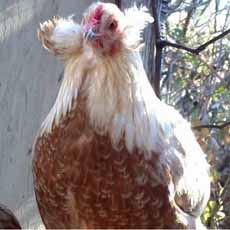|
May is National Egg Month, a time for some consciousness-raising.
We look for Certified Humane eggs and don’t mind paying the premium for them. You’ve no doubt heard the horror stories of mass egg production.
We buy from Pete and Gerry’s whenever we can: eggs produced on small family farms with a commitment to the humane treatment of the chickens.
Pete & Gerry’s eggs are also USDA Organic, OU kosher and B-Corporation Certified: committed to sustainability.
They shared these fowl facts with us:
There’s no nutritional difference between brown and white eggs. The color of the egg is actually determined by the color of the hen!
Young hens produce smaller eggs. The medium-size eggs come from pullets, hens that are less than a year old.
The smaller the egg, the thicker the shell. This makes them easier to crack (no fragments to fish out) and, for hard-boiled eggs, easier to peel.
What creates a double yolk? In a young hen that is just learning how to lay eggs, two eggs merged before the shell was formed.
All eggs aren’t equally flavorful. Aside from freshness (e.g., farmers market eggs), the tastiest eggs come from free-range hens they have real access to grass, where they can peck for worms and other insects that contribute to the flavor.
Fresh water, the space to roost and access to earth so they can dust-bathe are also essential. Cage-free and conventional hens spend their lives crammed together indoors. Cage-free hens aren’t confined to sit in a tiny cage, but are crammed onto the floor of a building with no room to move.
What’s the deal with cholesterol? In the 1980s, news warned against the consumption of eggs for people with high cholesterol. But the new news is, research has returned to the side of egg consumption. Don’t steer clear of eggs because of cholesterol. (If you have an issue, consult with your healthcare provider).
That’s good news, because…
The egg is a nutritional powerhouse, with 7 grams of high-quality protein, iron, vitamins, minerals and carotenoids, including the disease-fighting antioxidants lutein and zeaxanthin and the macro-ingredient choline. Yes, there are 5 grams of fat, but only 1.6 grams are saturated fat (types of fat). And all for just 75-78 calories per large egg.
The sell-by date, is not the expiration date. The eggs should be edible for a 3-4 weeks after that date. If you’re not sure an egg is still good, crack it. Your nose will perceive an unpleasant odor if the egg is no good.
|
|


These eggs are all natural in color. The colors come from different breeds of hens. Those breeds don’t produce eggs as economically as breeds that produce white and brown eggs, so they are not sold commercially, except by some farm stands (photo courtesy The Egg Farm). [2] This tufted arcauna chicken, originally from South America, lays pale blue eggs (photo courtesy Awesome Araucana.
|
Now for the fun trivia:
Why are eggs sold by the dozen? In England and other European countries from as early as the 700s and continuing until around 1960, the Imperial Unit System was used. There were twelve pennies to a shilling, which meant that an egg could be sold for a penny, or a dozen eggs could be sold for a shilling, with no change-making required.
By the Elizabethan period (1550-1600), selling eggs by the dozen was the standard practice. The English who emigrated to North America brought the system with them. Other countries have their own standards.
The world’s largest egg was laid in England in 2010, measuring a hefty 9.1 inches in diameter (photo).
The average American eats 250 eggs per year. If you eat a three-egg omelet every morning, so that means roughly 1,095 eggs per year .
TIPS
To crack an egg: The best technique is to tap it on the counter, not on the rim of the bowl. You’ll avoid fragments, splinters, or whatever you call those exasperating little pieces that drop into the bowl.
To check if an egg is fresh or stale, raw or hard boiled: Just spin the egg on the counter. If it wobbles, it’s raw. If it spins easily, it’s hard boiled. A fresh egg will sink in water, a stale one will float.
Egg sandwiches: A fried egg sandwich with bacon was popular in our youth. These days, one of our go-to quick meals for breakfast, lunch or light dinner is a sliced hard-boiled egg sandwich on rye toast. We buy the eggs pre-boiled and peeled (a great time saver!) and use an ever-changing variety of seasonal fixings (a favorite: roasted red pepper (pimento) with baby arugula) and mayo flavors. For weekend brunch: a slice of smoked salmon.
THE DIFFERENT TYPES OF EGGS
If you think of eggs as either white or brown, check out the different types of eggs in our Egg Glossary. There are 10 choices in chicken eggs alone!
SOME EGG-CELLENT LINKS
Egg Salad Recipes & The History Of Egg Salad
How To Make The Perfect Hard-Boiled Egg
Egg Nutrition
Quail Egg Recipes
|

